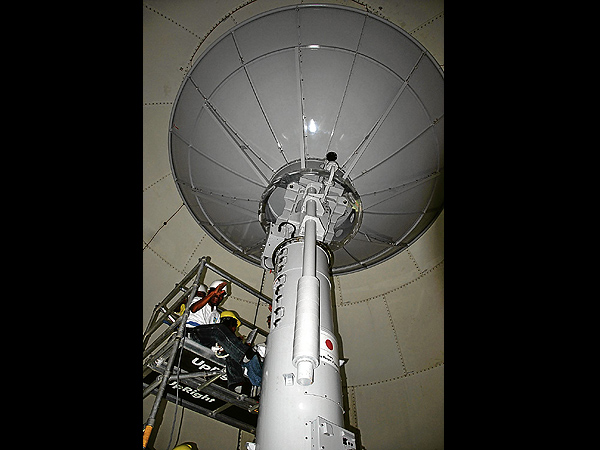
Weathermen familiarize themselves with the Doppler radar’s antenna under the guidance of Japanese technicians in Virac, Catanduanes, in January 2012. The Philippines’ 16th Doppler radar will be installed in 2014 at a naval base in Zamboanga City, a top science official said Monday, March 11, 2013. FERNAN GIANAN/INQUIRER SOUTHERN LUZON
MANILA, Philippines—No typhoon may now enter and make landfall in the country without being detected once the latest Doppler radar is installed next year at a naval base in Zamboanga City, a top science official said on Monday.
Science Secretary Mario Montejo made this assurance after the Department of Science and Technology (DOST) signed a deal with the Department of National Defense to establish the weather bureau’s latest Doppler radar station at the naval base in Romulo Espaldon, Lower Calarian.
The Doppler installation is expected to enhance the government’s capability to predict weather disturbances and effectively prevent death and destruction.
Zero casualty
In a speech during the signing of the memorandum of understanding (MOU) between the two agencies, Montejo said the installation of the Doppler radar station was part of the government’s campaign to achieve zero casualties in times of calamity.
“Times are changing, with the effects of climate change becoming more and more apparent. The typhoons, earthquakes, tsunamis and other disasters and calamities are becoming increasingly unpredictable and intense and more devastating,” Montejo noted.
He said the establishment of the Zamboanga Doppler radar station was part of the Nationwide Operational Assessment of Hazards (Project Noah) and would contribute to the improvement of the country’s national alert and communication system, particularly in western Mindanao.
Philippine Atmospheric, Geophysical and Astronomical Services Administration (Pagasa) Administrator Nathaniel Servando said the Zamboanga Doppler radar station would be the third to be set up in Mindanao.
“It is a vital part of the network of Pagasa Doppler radar stations to be established across the country,” Servando said.
There are currently 15 Doppler stations, he added.
Better prepared
“The Doppler radar is expected to help the government to effectively predict the direction, impact and intensity of weather disturbances, including typhoons, approaching the country which will make us better prepared,” Servando said.
Defense Secretary Voltaire Gazmin, who also chairs the National Disaster Risk Reduction and Management Council, said the new Doppler station would enhance the effectiveness of the NDRRMC through the use of information and communications technology in disaster prevention and mitigation.
“It shall likewise enable our armed forces to maximize its capability in addressing threats to national security with the enhancement of the Philippine Navy’s coast watch information system,” Gazmin said.
In a later interview, he told the Inquirer the system would be useful in military operations as it would offer real-time weather conditions.
For his part, Montejo said that with the system, “we do not have to wait for the typhoon to come to us.”
He explained that the Doppler radar station would further extend the current six-hour advance alert system for weather disturbances and give residents that may be affected more time to gather their belongings and flee to safety.